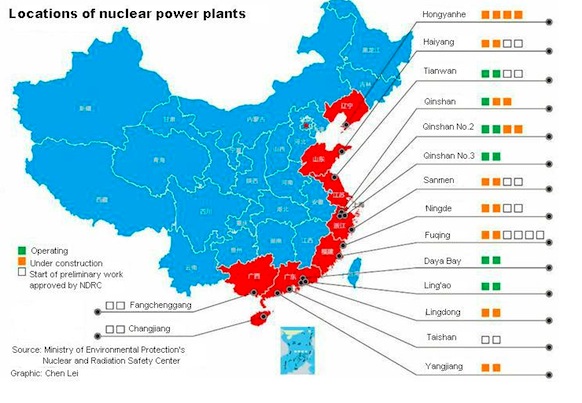China’s Nuclear Ambitions: Going Big at Home and Abroad
4 min read
Greentech Media: Headlines –
Three years ago, Beijing residents started hoarding iodine salt. Stores sold out of the commodity within days, and those with extra supplies jacked up prices to take advantage of the frantic demand.
China had not developed a sudden taste for salty foods. Instead, a frightened populace was trying to protect itself against any radiation blown west from Japan’s Fukushima nuclear plant, the site of the largest nuclear catastrophe since Chernobyl. Experts hit the airwaves telling the country that iodine salt was not a panacea against nuclear radiation. But panic was only heightened by the lack of transparency from Beijing, which unlike in a pre-Fukushima world, no longer seemed tolerable. For the first time, a truly national dialogue started over nuclear power, including the country’s ambitious targets to increase capacity fivefold to sevenfold by 2020. But in the three years since the nuclear accident in Japan, the national dialogue puttered out as concerns over economic growth and pollution reclaimed center stage.
Fukushima’s Legacy: Basically, the Same Old Plan
Before Fukushima, the hysteria that often surrounds nuclear power did not seem to exist in mainstream China. Questions about safety were met with a stern insistence that China needed more electricity from cleaner sources. Nuclear was just one of the many options Beijing was pursuing.
China was bullish on electricity demand and its plans for nuclear expansion. Back in 2009, officials and energy experts were predicting nuclear capacity would reach 70 gigawatts by 2020 from just 9.1 gigawatts, with a further 30 gigawatts under construction by the end of this decade.
In the immediate aftermath of the Fukushima disaster, as residents of coastal China checked wind patterns from Japan to determine whether they were safe, Beijing put a moratorium on new construction and ordered a review of all active plants (more on these measures here). The government later extended safety measures, requiring all new plants to use third-generation technology (the industry says third-generation technology is safer; the Fukushima Daiichi plant was built with older technology in the 1960s). With China keen to clean up its air and rely less on coal, the moratorium had many wondering if this would boost Chinese demand for natural gas, which could substitute as a cleaner-burning fuel.
But over the past year, China approved at least six new nuclear power facilities, according to the Shanghai Securities News. And on February 27, the Ministry of Environmental Protection (MEP) approved construction of two additional plants in eastern Shandong province. Instead of easing up significantly on nuclear, with the dearth of leadership from other countries, China seems to be grasping the opportunity to become an industry leader.
Besides a delay in building inland plants, the scare from Japan has not deterred plans already in place to increase China’s nuclear capacity to 40 gigawatts by 2015, part of the 12th Five-Year Plan that runs from 2011-2015. (Most of China’s nuclear plants are near the coast, where water is abundant and other sources of energy, such as coal and natural gas, are scarce.) Nuclear is just one piece of a more general trend toward using a larger percentage of non-fossil fuels for energy; Beijing wants 11.4 percent of China’s primary energy to come from non-fossil fuel sources by the end of next year, up from just 8.3 percent in 2010, split mainly between hydropower, nuclear and wind.

Source: Chinadialogue
New approvals signal Beijing’s commitment to nuclear power. This year alone, China is expected to add 13.95 gigawatts of new nuclear capacity, according to estimates on the World Nuclear Association’s website, almost doubling the country’s total capacity. Other estimates put capacity additions at a slower but still impressive 8.6 gigawatts this year. By 2020, China’s total capacity should reach 58 gigawatts, with that almost tripling by 2030 to 150 gigawatts.


Still, these numbers represent just a tiny fraction of the energy needed to power China’s factories and towns. China produced just 2 percent of its energy from nuclear in 2012, far behind most other countries with nuclear power. For example, France produced almost 75 percent of its energy needs from nuclear in 2012, while Slovakia relied on nuclear power for more than half its electrical needs. But country comparisons tend to skew the picture: in 2012, China produced 92.7 terawatt-hours of nuclear power, similar to both Canada at 89.1 terawatt-hours and Germany at 94.1 terawatt-hours, but nuclear represented 15.3 percent and 16.1 percent of those two countries' electrical needs, respectively.

Beyond China’s Borders
China’s nuclear ambitions aren’t limited to its borders or by state financing. Beijing is hoping to expand its influence in countries that did not abandon the energy source after Fukushima. It seems likely that Beijing is trying to capitalize on the absence of other major players in the last few years to promote its own technology. Beijing wants to export the CAP 1400, which stands for China Advanced Passive — a third-generation technology based on Westinghouse’s AP 1000 reactors — to expand China’s presence in countries like Brazil, Russia and South Africa. And China’s state-owned nuclear companies are looking at opportunities in more developed markets as well. China General Nuclear Corporation and China National Nuclear Corporation are buying into the Hinkley Point nuclear power project in Somerset, England. Beijing is also looking to buy into uranium mines in other countries.
In the massive buildup planned for 2020 and beyond, two of China’s largest nuclear companies are looking to go public on the Hong Kong exchange. The move will open the companies up to further scrutiny, both at home and abroad, similar to the process China’s state-owned oil companies went through. But don’t expect an IPO to usher in greater transparency from Beijing — that will have to come from domestic pressure.
***
Editor's note: This article is reposted from Breaking Energy. Author credit goes to Kate Rosow Chrisman.
(c) Greentech Media: Headlines – Read entire story here.




